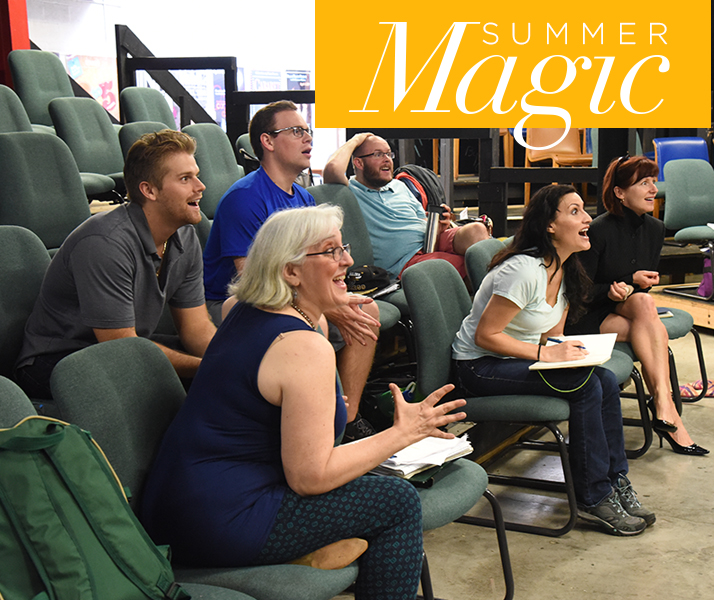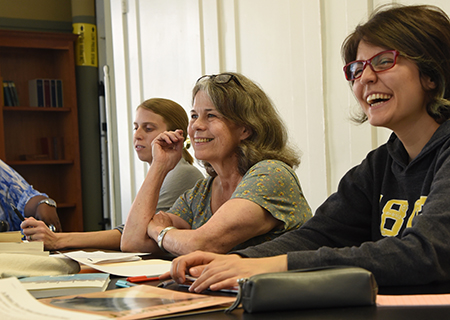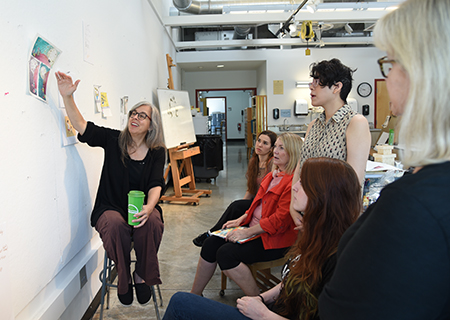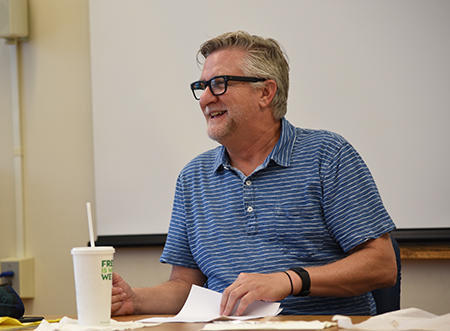
Summer Magic
By Jeff Hodges M.A.L.S. ’11

Playwriting students in the scene studies class
Each summer, writers, artists, and scholars converge on campus for six weeks of academic rigor and self-discovery, building community, generating ideas, and living in the moment with focus and intensity. They enjoy every minute.
Hollins’ summer graduate programs in playwriting, children’s literature, children’s book writing and illustrating, and screenwriting and film studies have carved out their own unique identities. But the similarities they share also play a major role in persuading students from all over the country to give up a significant part of their summers to enroll.
“We offer low-risk opportunities to learn to take big risks,” explains Todd Ristau, director of the playwriting M.F.A. program. Kelly Fullerton, who teaches in the M.A./M.F.A. program in screenwriting and film studies, adds, “We’re in the business of teaching students how to overcome discouragement and defeat the demons that keep them from moving forward.”
Each of the disciplines is inspired by prestigious programs across America, from UCLA and the University of Iowa to Hollins’ own nationally recognized creative writing program. None of the programs begins and ends with the six-week summer session. Throughout the rest of the year each is connecting with students through online courses, an active social media presence, and other initiatives.
“We develop a relationship with faculty because they care. We keep in touch with them,” says Rebekah Lowell, a student in the children’s book writing and illustrating program, while children’s literature student Cassie Gustafson notes, “We’re sharing resources, we meet up at conferences. We’re called the ‘Hollins Mafia’ because we cluster and we pick up right where we leave off.” Bob Moss, professional resident teaching artist in the summer M.F.A. playwriting program, compares the six-week sessions to “putting money in the bank. Once you get out of here, you start drawing it out.”
For playwriting student Nick McCord, summer at Hollins has represented an epiphany. “The beautiful thing about this is that we’ve all been given an investment in each other’s lives that has both immediacy and relativism. Everybody wants to make art. Everybody wants to work with people that they love. At Hollins, I understood the two aren’t mutually exclusive.”
![]()
“People everyone will want to work with”

Bob Moss’s directing class
“Playwright’s Lab” may seem an oddly clinical name for a graduate program devoted to an art form. But to Bob Moss, the moniker fits.
“We’re like scientists creating modules of human behavior. We’re looking at them under a magnifying glass and saying, ‘Hmmm, I don’t know if I got that right. Let’s put another example of human behavior under a magnifying glass and look at it.’”
The Playwright’s Lab encompasses three fields: playwriting, directing, and acting. Founder and director Todd Ristau used his experience as an undergraduate and graduate student at the University of Iowa to “design the program I wish I’d gone to, where we have highly motivated theatre practitioners who want to work in an interdisciplinary way and value others in the process. They know what it’s like to audition, they know what directors do, they know how to work together because they’ve got experience in each of the different disciplines of the medium for which they are writing.
“At Hollins, our students model behavior that reinforces theatre as a shared art form that’s there for everyone’s mutual benefit.”
Faculty and students tout collaboration. Whether they are playwrights, directors, or actors, each student comes out of the program with a “collaborative vocabulary,” according to faculty member Saffron Henke, an acting and directing professor at Miami University. “We’re taking care of each other’s experiences and learning how to be collaborative in an honest and compassionate way,” says Emma Sperka ’12, who majored in theatre as an undergraduate at Hollins and is now a first-year student in the performance certificate program. Ronald Blanks Jr., another student in performance, feels “the family atmosphere is the core of everything. It’s okay not to get it right the first time. Somebody’s going to help you mold it to get it where you want it to go.” And playwright Meredith Cope-Levy ’12 simply states, “My peers have become my teachers as much as the faculty are my teachers.”
“We’re training our students to be people that everyone will want to work with,” states Ristau. “I know lots of people in the profession who seek out Hollins grads. They know they can trust them to get the work done without being confrontational.”
At the same time, Cope-Levy dispels the notion that there is a “Hollins playwright.” “It’s not about fitting us into a mold,” she says. “It’s about giving us space to become the best artists possible.” Henke notes, “This environment facilitates personal expression of whatever kind of work you want to make. Graduates are empowered, not overwhelmed.”
Moss finds the honesty and compassion “astonishing. We’re helping each other constructively, thoughtfully, and lovingly without being sentimental and without lying.” Adds Ristau, “I feel the greatest validation from the success of the individual students, but also when our guest professionals come here as faculty or speakers. They tell me the same thing: ‘I wish I’d gone to Hollins.’”
![]()
“Creative energy I’ve never experienced anywhere else”

Program director Amanda Cockrell (middle) teaching a genre study class
When Amanda Cockrell ’69, M.A. ’88 launched a graduate program at Hollins focusing on the study and writing of children’s literature in 1992, she didn’t have to look far to find the right model.
“There’s this theory that if you can’t take blistering criticism, you shouldn’t be a writer. How many promising writers are now not writing because some teacher told them they had to be tough, and if they couldn’t take it to get out of the field? Good teachers, editors, and peers don’t do that.”
Cockrell earned her M.A. in Hollins’ graduate program in creative writing, where the hallmark is “safety. It’s not cutthroat. People cheer each other’s success.”
She embraces that approach. “Structurally, the children’s literature program has evolved a lot, but our philosophy has remained the same: Help writers and scholars find their voice and teach them to perfect their craft.”
Students say they’ve gained unprecedented self-confidence as a result of that nurturing environment. Reflecting on three summers in the program, Cassie Gustafson says, “For the first time in my life I can say I am a writer. I found my calling and where I needed to be. I’ve discovered the pieces that were missing from my toolbox. I can be creative and explore this side of me I never allowed myself to experience before.”
“Where better could I find a place to study and write about the things I’ve loved all my life?” adds Michael Jones, a third-year M.F.A. student. “Being around all these wonderful people has expanded my mind.”
Those include faculty members such as Hillary Homzie, who holds an M.A. [’98] in children’s literature and writing from Hollins. “It was life-changing. I felt like a piece of me had been missing until I came to this program. I see the look of joy on the faces of first-year graduate students now and I say, ‘Yes! It only continues!’”
Gustafson says the six-week sessions unleash “this creative energy I’ve never enjoyed anywhere else,” and Jones’s preconceived idea that grad school was “terrifying, brutal” was squelched his first day. “I went home and asked my wife, ‘It’s okay for grad school to be fun?’ I have never not had fun in three years.”
Faculty member Nancy Ruth Patterson believes a sensitivity to the role feelings play in the classroom is crucial to the program. “I start every class by saying, ‘You will leave this room with your dignity intact. You will leave this room feeling better about yourself as a potential writer than you did when you came in.’”
“To me, the Hollins campus is a protective bubble. I want to replicate that in the classroom,” says Homzie. “We are careful about communicating in a supportive, empowering, and loving way. Everybody here works hard at mirroring that attitude. It’s just the beginning of taking Hollins wherever you go.”
![]()
“We’re at the cutting edge”

Illustrations from Ruth Sanderson’s children’s book media class
Ruth Sanderson has earned acclaim as the author/illustrator of many children’s books. Her accomplishments as a writer and an artist were delayed, however, for one unfortunate reason.
“When I went to art school there was no writing,” she recalls. “If I had had writing in school, I would have become an author/illustrator faster. Fifteen years after I graduated I was finally brave enough to submit writing.”
Today, the codirector of Hollins’ graduate program in children’s book writing and illustrating, the first of its kind, is helping fledgling author/illustrators avoid that pitfall.
“We have carved out this niche because at most universities the English department is very separate from the art department,” Sanderson explains. “For this combination to happen, you have to have a strong children’s book writing program and a strong illustration program in the same school. Here, the idea seemed like a no-brainer.”

Elizabeth Dulemba teaching a class in children’s book design
“Author/illustrators are in demand with agents and editors because it’s cheaper and easier to work with one person,” says faculty member Elizabeth Dulemba, herself an award-winning author/illustrator. “As far as the industry is concerned, we’re at the cutting edge.”
Students in the program are generally illustrators who wish to enhance their writing skills rather than vice versa, which faculty member Ashley Wolff says “is a harder thing to do. It’s rare to find an author who becomes an illustrator.”
For students with a strong background in illustration such as Lucy Rowe, “it’s been a good challenge and a good decision.”
Likewise, fellow student Rebekah Lowell appreciates the “great opportunity to stretch yourself and grow. I expected to come here and work hard and I’m getting everything I hoped for.”
Dulemba believes the transition is easier for illustrators because “they are story makers already. They are always illustrating the stories that are in their head. And this program lets them hopefully become employed story makers.”
To that end, Sanderson says the program emphasizes the business of a writing/illustrating career along with developing the craft. “Our goal is to have students find a way of working that pleases them and the marketplace.”
Lowell, who was a wildlife artist before coming to Hollins, is seeing that goal come to fruition with what she calls “a style breakthrough. I’m taking my art that won’t translate into picture books and coming up with new ways of working. I don’t think that would’ve happened if I wasn’t here.”
![]()
“Bringing a little bit of LA to Virginia”
“If you want discouragement in Hollywood, you’ll find it.”

Tim Albaugh, director of the program in screenwriting and film studies
An award-winning television and film writer, Kelly Fullerton has experienced firsthand the ups and downs of a show business career. Helping new screenwriters navigate the intimidating world of story pitches, rewrites, and criticism and rejection became a calling. When longtime friend and mentor Tim Albaugh approached her about joining the faculty of the master’s program in screenwriting and film studies he directs, she says there were good reasons to accept.
“First, how far away Hollins is from Hollywood. The business is such a distraction and I’m not sure LA is the best venue to focus on writing. Hollins is idyllic because it has all these different places to write.
“Second is affordability. For many students, grad school at other institutions is too expensive.” At Hollins, Fullerton says, students pay much less to get the benefits found in other major screenwriting programs.
“The third piece is access to professors and guest speakers. You build these amazing relationships by being together constantly. I tell my students, ‘Once you’re in a class with me, you’re always in a class with me.’”
The attention he received from faculty surprised third-year student Alex del Campo. “At other schools, your time with the instructor is in class. Here, it’s six weeks of ongoing interaction and bouncing ideas off one another. They’re invested in us and our success after we leave.”
Fellow student Anna Fahr agrees. “We get one-on-one instruction both inside and outside the classroom that’s valuable as we’re learning to develop our craft.”
For 25 years, Albaugh has taught in UCLA’s M.F.A. screenwriting program.
Any similarities between UCLA and Hollins are intentional. “What I wanted to do was build on UCLA’s core components. For example, last summer we added a web series production course that’s not taught at any other school.”
Albaugh says the program’s strength lies in its flexibility to offer something different each summer. “We can react to industry trends on the fly. That isn’t possible at a larger institution because you have to jump through so many hoops to make something happen.
“Our focus in the program is not only to make people better writers but also to prepare them for the reality of the business. We take it upon ourselves to give people the tools they need to thrive. I bring a little bit of LA to Virginia every summer. The teachers and guests I invite are all working professionals there. They’ve been in the trenches and they know what it takes to succeed.”
Albaugh emphasizes that a degree in film is not a prerequisite. “I’m more interested in people who have stories to tell, people with a liberal arts background.” Fullerton notes that military veterans in the program particularly “have interesting things to say. Their life experience adds to the variety of different backgrounds we seek. It’s exciting to be in a classroom with this mix of people.”
Fullerton believes the buzz about Hollins screenwriting is growing. “Students are hearing they can come here and get a world-class education.”
Jeff Hodges is director of public relations.
Photos by Sharon Meador
